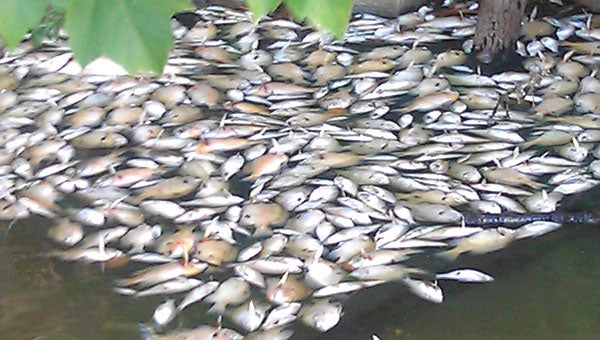Fish kill
Published 12:01 am Saturday, July 16, 2011

Dead fish line the shore of North Suffolk’s Sleepy Lake following a fish kill that started Thursday morning. Volunteers from the community turned out Friday to begin a cleanup process that was expected to last at least through Saturday.
Community reels from calamity on its lake
Wearing long rubber gloves and sporting long-handled fishing nets and contractor-grade garbage bags, a group of volunteers spent the day Friday scooping and bagging tens of thousands of fish that died in Sleepy Lake the previous day.
Residents of the North Suffolk community expected to continue the cleanup today, as the weather forecast predicted perfect conditions for a malodorous eruption in coming days if the fish kill is not handled quickly.
“We took a chunk out of it,” Sleepy Lake Homeowners Association President Marcel Berrios said Friday evening, after spending about eight hours working with other residents hauling dead fish in bags, buckets and even a canoe that was used as a barge to a picnic area by the community’s dam for later pickup by Suffolk sanitation workers.
“But the more we look, the more we find,” he added.
Berrios said dead fish began turning up in the lake around 10:30 or so Thursday morning. By late afternoon, with the wind blowing from the northeast, the banks of many of the coves in the Sleepy Lake West section of the community were lined with dead fish floating in shore-hugging ribbons as much as two to three feet wide.
The odor of rotting fish permeated the community on Friday.
This is not the first time Sleepy Lake has had a fish kill. The last one happened in 2008, also in July, when a cold rainstorm during an especially hot summer mixed up the warm, oxygen-rich upper layers of water with the cool, de-oxygenated bottom layer, causing what is called “turnover,” which, according to the Virginia Department of Game and Inland Fisheries, is a common cause of fish kills in lakes and ponds.
Following that event, which killed all of the fish in the lake, the homeowners’ association paid for it to be restocked and for a dozen or so aerators to be installed in various locations, with the idea that they aerators would help reduce the separation of water into layers with different oxygen content.
The aerators, Berrios said, probably helped to limit Thursday’s fish kill, which they believe resulted from a combination of high algae levels and a turnover event caused by rapid cooling of the air above the lake when temperatures suddenly dropped and the wind picked up earlier this week.
On a tour of the lake Friday morning, a few small fish could be seen swimming at the surface of the water, gasping for breath. Berrios and others were hopeful that some of the fish in Sleepy Lake would survive. He expects no immediate effort to restock the lake until an assessment can be made of the problem and a solution put into place, probably before next summer.
“Our goal is definitely to have the lake treated in some way, shape or form,” he said.
Volunteers are still needed to help clean the dead fish from the lake, which covers an area larger than 50 acres, Berrios said. Those who would like to help should go to the picnic area by the dam on Carters Cove Road, where they can get bags and nets.






